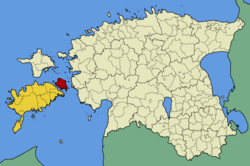Muhu

Muhu (Template:Lang-de; in Estonian also called Muhumaa), is an island in the Baltic Sea. With an area of 198 km2 (76 sq mi) it is the third largest island belonging to Estonia, after Saaremaa and Hiiumaa.
Together with neighbouring smaller islands of Kesselaid, Viirelaid, Võilaid and Suurlaid it forms Muhu Parish (Template:Lang-et), the rural municipality within Saare County. The municipality has a population of 1,697 (as of 19 April 2010) and covers an area of 206.12 km2 (80 sq mi). The population density is 8.8/km2 (23/sq mi).
Geography
The most important villages in Muhu are Kuivastu, Liiva (where the school can be found) and Koguva. In Pädaste, an internationally renowned luxury hotel and spa operates in the restored manor house.
The island is divided from mainland Estonia by the Suur Strait (Moonsund) and from Saaremaa by the Väike Strait. It is linked by ferry to Virtsu in the mainland, and to Saaremaa by a causeway, the Väinatamm. In winter an ice road connects the island to the mainland.
In January 1227, an army of the Livonian Brothers of the Sword with Letts, Germans of Riga and native Livonians (20,000 men commanded by William of Modena) crossed on sea ice from the mainland and attacked the island of Saaremaa to reduce the last holdout of pagan Estonians. The Estonians surrendered on Muhu at a circular stronghold called Mona, the earthworks of which are still preserved near the causeway between the islands. This ended the Estonian Crusade.
The Battle of Karuse or Battle on the Ice was fought on 16 February 1270 between the Grand Duchy of Lithuania and the Livonian Order on the frozen Baltic Sea between the Muhu Island and the mainland. The Lithuanians achieved a decisive victory. The battle, named after the Karuse village, was the fifth-largest defeat of the Livonian or Teutonic Orders in the 13th century.
The same waters saw the Battle of Moon Sound in September–October 1917 between Russian and German naval forces.
Muhu is also famous for having the only still-working traditional windmills in Estonia.
Muhu is the home of Estonia's first wine tourism farm – Luscher & Matiesen Muhu Winehouse.
Villages of Muhu Parish
Aljava - Hellamaa - Igaküla - Kallaste - Kantsi - Kapi - Kesse - Koguva - Kuivastu - Külasema - Laheküla - Lalli - Leeskopa - Lehtmetsa - Lepiku - Levalõpme - Liiva - Linnuse - Lõetsa - Mäla - Mõega - Mõisaküla - Nautse - Nõmmküla - Nurme - Oina - Pädaste - Päelda - Paenase - Pallasmaa - Pärase - Piiri - Põitse - Raegma - Rannaküla - Rässa - Raugi - Rebaski - Ridasi - Rinsi - Rootsivere - Simisti - Soonda - Suuremõisa - Tamse - Tupenurme - Tusti - Vahtraste - Vanamõisa - Viira - Võiküla - Võlla
Gallery
-
Northern coast of Muhu
-
Muhu Stronghold, site of the native Estonian surrender to crusaders in 1227
-
Monument in the center of the Muhu Stronghold
-
Üügu cliffs
-
Muhu museum
-
Students and teachers in traditional clothing march in a procession in Liiva
-
Old village school
-
In Mõega village
-
Muhu traditional clothes
-
Windmill in Koguva
See also
External links
 Media related to Muhu at Wikimedia Commons
Media related to Muhu at Wikimedia Commons- Official website
- Muhu Tourism Association
- Muhu Island in Jetsetter Top10
- Photos about Muhu.












